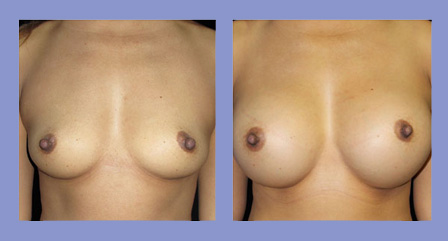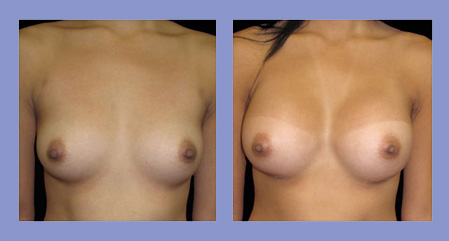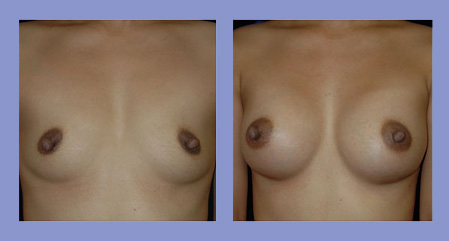— Verve Patient
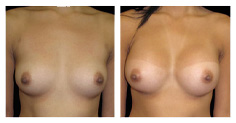
Breast Augmentation
Quick Links
Reasons to Consider Augmentation
- Tubular breasts
- Small breasts
- Asymmetric breasts
- Desire for larger breasts
- Loose skin after pregnancy or weight loss
- Breast implant revision
Tubular breasts
 Tuberous breasts are a common developmental condition that affects the shape of the breast. They typically present with breast constriction, small breast size or underdeveloped breasts, puffiness or bulging of the nipple-areola complex and asymmetry. One or all of these features may be present.
Tuberous breasts are a common developmental condition that affects the shape of the breast. They typically present with breast constriction, small breast size or underdeveloped breasts, puffiness or bulging of the nipple-areola complex and asymmetry. One or all of these features may be present.Small breasts
 Many women with A or B cup breasts have a desire to achieve a fuller bust to feel most confident in clothing. Breast implants are the best way to achieve a full increase of more than 1 cup size. Carefully planning will be needed to choose the ideal implant for each candidate in order to keep the incision and the feeling of the implant as discrete as possible.
Many women with A or B cup breasts have a desire to achieve a fuller bust to feel most confident in clothing. Breast implants are the best way to achieve a full increase of more than 1 cup size. Carefully planning will be needed to choose the ideal implant for each candidate in order to keep the incision and the feeling of the implant as discrete as possible.Asymmetric breasts
 Most women have some asymmetry between their breast. Breast augmentation allows for correction of this asymmetry. With carefull measurements and
complete assessment, ,different size, shape or style implants can be utilized to achieve improved symmetry.
Most women have some asymmetry between their breast. Breast augmentation allows for correction of this asymmetry. With carefull measurements and
complete assessment, ,different size, shape or style implants can be utilized to achieve improved symmetry.Desire for larger breasts
 Many women with large breasts have a desire for fuller results. Placing an implant allows for more fullness at the top of the breasts and better cleavage.
Many women with large breasts have a desire for fuller results. Placing an implant allows for more fullness at the top of the breasts and better cleavage.Loose skin after pregnancy or weight loss
 After pregnancy or weight loss women lose natural volume in the breasts. They often wish to restore their pre-pregnancy breasts and breast augmentation is a great option.
After pregnancy or weight loss women lose natural volume in the breasts. They often wish to restore their pre-pregnancy breasts and breast augmentation is a great option.Breast implant revision
 If you have previously had a breast augmentation and are experiencing
complications or less than ideal results, you are an excellent candidate for a breast implant revision. The most common complications we see from prior implants include: asymmetry, capsular contracture, hardening of the implants, breast pain or implant rupture. Advanced techniques are needed to perform breast augmentation revisions to ensure you don’t have the same complications in the future.
If you have previously had a breast augmentation and are experiencing
complications or less than ideal results, you are an excellent candidate for a breast implant revision. The most common complications we see from prior implants include: asymmetry, capsular contracture, hardening of the implants, breast pain or implant rupture. Advanced techniques are needed to perform breast augmentation revisions to ensure you don’t have the same complications in the future.Tubular breasts

Tuberous breasts are a common developmental condition that affects the shape of the breast. They typically present with breast constriction, small breast size or underdeveloped breasts, puffiness or bulging of the nipple-areola complex and asymmetry. One or all of these features may be present.
Small breasts

Many women with A or B cup breasts have a desire to achieve a fuller bust to feel most confident in clothing. Breast implants are the best way to achieve a full increase of more than 1 cup size. Carefully planning will be needed to choose the ideal implant for each candidate in order to keep the incision and the feeling of the implant as discrete as possible.
Asymmetric breasts

Most women have some asymmetry between their breast. Breast augmentation allows for correction of this asymmetry. With carefull measurements and complete assessment, ,different size, shape or style implants can be utilized to achieve improved symmetry.
Desire for larger breasts

Many women with large breasts have a desire for fuller results. Placing an implant allows for more fullness at the top of the breasts and better cleavage.
Loose skin after pregnancy or weight loss

After pregnancy or weight loss women lose natural volume in the breasts. They often wish to restore their pre-pregnancy breasts and breast augmentation is a great option.
Breast implant revision

If you have previously had a breast augmentation and are experiencing complications or less than ideal results, you are an excellent candidate for a breast implant revision. The most common complications we see from prior implants include: asymmetry, capsular contracture, hardening of the implants, breast pain or implant rupture. Advanced techniques are needed to perform breast augmentation revisions to ensure you don’t have the same complications in the future.
The Incisions
Inframammary Incision
A small and discrete incision is created in the breast crease. This is the most commonly used incision as it allows for no-touch placement of the implant with the lowest incident of capsular contracture.
Peri-areolar Incision
A small semi-circular incision is made around either the top of bottom of the areola. The benefits of this incision is that is extremely discrete; however, there can be some changes in the sensation to the nipple or areola. There is slightly high chance of complications including capsular contracture compared with the inframammary incision.
Transaxillary Incision
A small incision in your armpit area. This incision is not advised as it tends to have high post-operative pain and increased complications – such as asymmetry.
Transumbilical
This approach is no longer recommended. Saline implants were placed through an incision in the belly button then tunneled to the breast. This has a very high incident of complications and asymmetry.
Procedure Video
[Title screen for breast augmentation]
[Woman smiling confidently]
[Dr. Anshu Gupta explains breast augmentation]
Breast augmentation is typically done to enhance the volume of the breast, but it can also be done to correct asymmetry or to fill in the loose skin that occurs after pregnancies or weight loss.
[Woman posing to show breasts confidently]
[On-screen text of breast augmentation purposes: increase volume, correct asymmetry, & fill in loose skin]
[Dr. Anshu Gupta having 1-on-1 consultations with clients]
The key thing for breast augmentation is that every patient is different.
You have to tailor the procedure to the patient.
You have to pick the right size of the implant, the correct placement of the implant, and choose the right incision. Absolutely.
[Dr. Anshu Gupta showing a client the different sizes of implants]
Patients can come in with a very clear cut mind of what size they want, or they can try different sizes.
Here we have special sizes that go into the bra and they can look in the mirror and decide what’s best on them.
[Images of silicone gel implants and saline implants]
The two main types of implants that we use for breast augmentation are saline implants and silicone implants. Saline implants feel a little bit more firm and silicone implants feel a little bit more natural.
[Images of before and after photos from clients]
[Women smiling as they pose and look in the mirror]
[Dr. Anshu Gupta talking]
Most women will feel empowered after this procedure. They have more self-confidence. They are going out more.
We see them networking a lot better and just feel good about themselves.
[Closing title screen with Verve Plastic Surgery logo]
[Call today (760) 436-7600]
Types of Implants
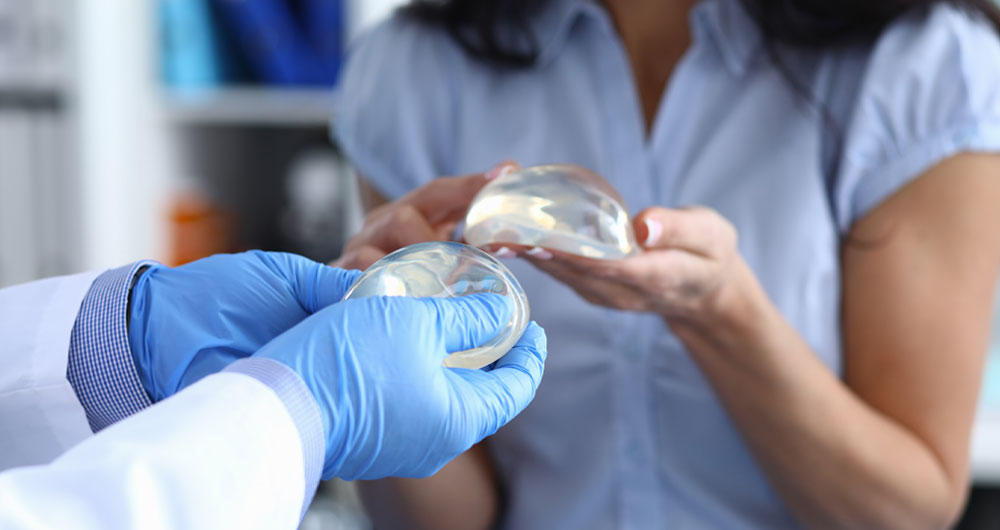
Saline
Best suited for patients that have B + volume of natural breast tissue as you don’t want them to be palpable.
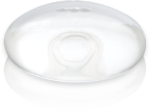
There are newer styles of saline implants with 2 chambers for saline. They are called Ideal Implant and they tend to look a feel more like silicone implants.
Silicone
All silicone implants are now made of a cohesive gel, also referred to as “gummy bear”. This cohesive gel does not leak out into the tissue or to the lymph nodes if there is a rupture, rather, it continues to hold its shape like a gummy bear.
FAQs
Rippling is a where the implant’s folds and wrinkles become visible under on skin, especially in women who are very thin, or when they lean forward. It is most common when saline filled implants are chosen, and they are over or under filled. Rippling is also more common with certain implant shapes, and when the implants are placed above the muscle. Rippling can be prevented by choosing to place the implants below the muscle, and to assure there is adequate breast tissue, and to use silicone implants, which are more form stable. It is important to note that you are likely able to feel the implant in the lower outside quadrant of the breast. This is normal.
If you have concerns about rippling, talk to Dr. Gupta. He can do fat grafting to make ripples and irregularities less noticeable.
The formation of a capsule of scar tissues is normal and helps keep the implants in the correct position. But, when the body reacts to the implant by forming excessive scar tissue, the breast can become hard and painful. And the aesthetics of the implant may be compromised. This is capsular contraction.
It is not because the implants are somehow dangerous or toxic, or that a mistake was made during surgery. It is not dangerous. But patients who are prone to developing thick scars, have autoimmune diseases or compromised immune systems are more likely to experience this complication.
It is uncommon, and the risk can be reduced by placing the implants under the muscle. It occurs during healing and the majority of cases occur within 2 years of surgery. If capsular contracture occurs after that, it is likely due to a rupture.
It is highly treatable and there are specific techniques to treat this complication and improve the appearance of the affected implant.
There may be some sensory changes as a result of augmentation, especially when a large implant is chosen. Usually the sensation returns within 3-6 months, especially when the implant is placed below the muscle. Incision in the inframammary fold – where the breast connects to the chest, has the lowest ratio of sensation loss – 5-10% loss.
Cleavage depends on the amount of breast tissue, shape and diameter of your own breasts, and the degree of enhancement. Just increasing the breast size doesn’t always increase cleavage.
Breast augmentation can increase fullness and projection, correct breast asymmetry, improve the balance between your breasts and hips, and enhance your self-image and confidence.
Dr. Anshu Gupta is a leading plastic surgeon in Solana Beach, CA. His breast augmentation outcomes are beautiful and natural-looking. He marries science and his artistic eye to deliver your desired enhancement. To find out how you can attain, larger, fuller, and more proportionate breasts, contact Verve Plastic Surgery in Solana Beach, CA to schedule your consultation.
Request an Appointment
Call (760) 436-7600 or fill out the form to schedule an appointment to discuss your needs in detail
